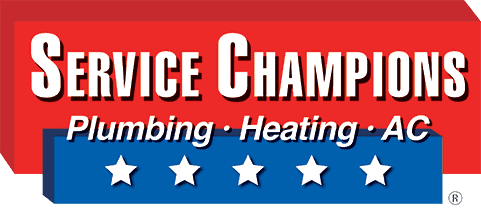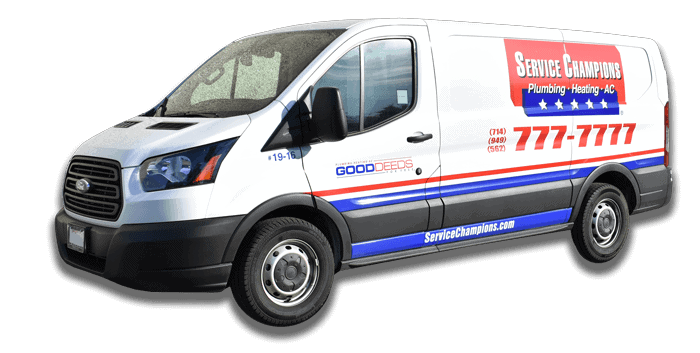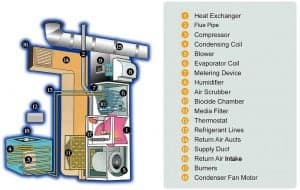Four Common Misunderstandings About How Your AC Works and How to Use It
Servicing thousands of homes each year has given Service Champions technicians a trained eye for detecting problems common to Southern California air conditioning systems. When these problems are left unattended, they pose a greater threat later down the line that compromises the system’s performance altogether or even the health of the home. Equipping yourself with this basic information will help you make the right choices for your home and central air system. Because of this we’re sharing common misunderstandings about how your AC works.
Problem #1: Homeowners let the heat load get too high
When homeowners leave the home for more than three to four hours at a time during peak heat periods, they oftentimes close their windows and doors which will result in no home ventilation. While they’re out, the indoor home temperature rises considerably. For example, it can be 95 degrees outside and by the time you arrive home the indoor temperature has risen to 88 degrees.
This is an uncomfortable temperature for most families so turning on the air conditioner is the logical solution, usually set in between 73 to 75 degrees. Unfortunately, even if the air conditioning never turns off, it may take hours to lower indoor room temperature (as a whole) from 88 degrees to 75 degrees.
When the home gets too hot and the AC has to work overtime, it:
- Stresses out the air conditioning system, adding strain

- Expends extra energy
- Costs more to cool the home now and maintain later
Solution:
When you know you’ll be out of the house during peak heat hours, leave the air conditioner on to a reasonable temperature (78 to 80 degrees). That way, when you return home you can adjust the thermostat to a comfortable 75 without stressing out your air conditioner.
Problem #2: A lower number on the thermostat does not mean cooler air
Each central air system works to cool air by 15 to 20 degrees at a time. As an example, if the indoor air temperature is at 80 degrees, the AC system takes that supply of air and subtracts 15 to 20 degrees of heat before releasing it back into the home air supply. Because it mixes with the other 80 degree air that has not been conditioned yet, the air you feel will be cooler but not necessarily the temperature that you set on your thermostat. It takes time for the indoor air to reach temperature equilibrium.
However, if you detect the mixing of conditioned air and the indoor air supply is not the reason for poorly conditioned air there may be a greater issue. Though air is still conditioned, it is less efficient, working twice as hard to cool the same amount of air.
Solution:
If your air is not cooling air in 15 to 20 degree increments, a maintenance call is required to restore proper function and efficiency levels.
Problem #3: Homeowners ignore filter maintenance
A good maintenance call scheduled regularly eliminates issues with poor or dirty filtration. From stuffed filters to build-up over the evaporator coils, keeping your central air system clean not only benefits the system itself but the sanitation of the air you breathe inside of your home.
When air filters are not replaced or cleaned out it adds strain upon the AC because it is now more restrictive than before. This means less air gets through the filter and less air is conditioned. If this happens, it also causes the evaporator coils to ice up while the system overheats.
The evaporator coils are hollow tubes through which refrigerant flows. Once the refrigerant reaches the evaporator coils, the coils grow cold so that the indoor air supply that passes over them are cooled before returning into your home. Something as simple as a dirty filter can stop this process because less room temperature air passes over the coils which in turn ice up.
Likewise, poor air flow due to dirty filters encourages the system to overheat and shut down. This is because a central air system needs a heat source to function and restricted air flow means the same amount of energy is used for less and less air.
Filters that are not serviced are the number one reason to system shut-downs.
Solution:
Have your preferred HVAC technician visit to service your AC system. Be sure to replace filters and have the evaporator coils and drip pans cleaned. These areas collect water and are prone to microbiological growth.
Problem #4: The AC system is not an open system
Homeowners, new and old, have a tendency to think that their air conditioning system is an open system. This is not the case. Contrary to popular belief, there is no need to refill your refrigerant supply.
Given that your AC system was installed properly and there are no leaks that have accumulated during its lifespan, the same supply of refrigerant is recycled each and every single day.
However, if your refrigerant supply does experience a leak, it requires the attention of a HVAC technician as soon as possible. Refrigerant is a gas that damages the ozone layer if released into the atmosphere. Your technician can repair the leak and restore its proper supply.
When your refrigerant supply does drop due to a leak, the system is less efficient because it has less cooling power to work with. If your AC system previously cooled indoor air in 20 degree increments, it now may be cooling in 10 degree increments; the air conditioner works harder to condition the same amount of air.
Solution:
Have your preferred HVAC technician repair the leak, refill refrigerant and recalibrate.
Service Champions are Experts on Air
As technicians, we provide professional services and products to help each home achieve their goals on perfecting home air conditioning. To book an appointment with your Service Champions technician contact one of our friendly representatives in our call center and schedule a visit that best fits you. Our technicians can help you with common misunderstandings about how your AC works.
Technicians train for 150 hours every year in our own private training facility. We learn of the latest developments in HVAC technology so we always care for your central air system with the most advanced methods available.
All technicians pass drug tests and background checks. For your additional comfort and safety, we provide an e-mail containing the photo ID of your technician prior to your appointment.
Schedule Service
Oops! We could not locate your form.


